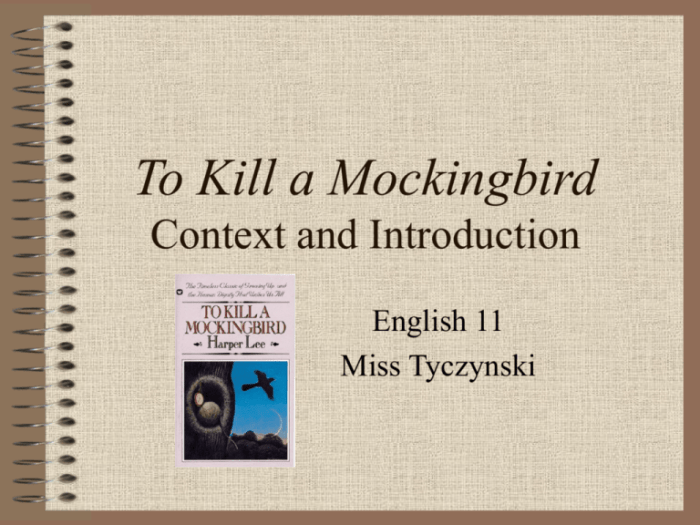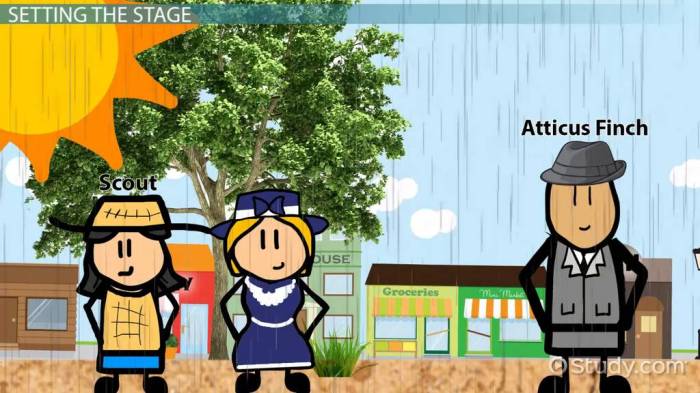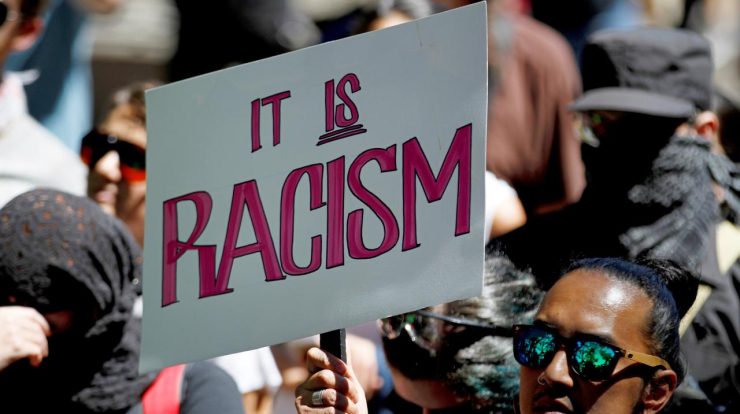Classism in to kill a mockingbird – In Harper Lee’s classic novel, To Kill a Mockingbird, classism takes center stage, shaping the lives of characters and revealing the deep-seated prejudices that permeate society. This essay delves into the complex tapestry of class relations within the novel, exploring its impact on individuals, the justice system, and the protagonist’s journey towards understanding.
The rigid social hierarchy in Maycomb, Alabama, forms the backdrop for the story, with race and economic status serving as defining factors in social interactions and perceptions. Tom Robinson, an African American man falsely accused of a crime, becomes a symbol of the oppressed class, while the trial against him exposes the biases and prejudices that run rampant within the community.
Social Hierarchy and Prejudice
Maycomb society operates on a rigid social hierarchy that divides individuals based on race, class, and family background. At the top are the wealthy white families, such as the Finches, while at the bottom are the poor black families, such as the Robinsons.
This hierarchy shapes social interactions and perceptions, creating a system of privilege and oppression.
Role of Race and Class
- Race is a primary determinant of social status in Maycomb. White people are considered superior to black people, regardless of their class or wealth.
- Class also plays a role in shaping social interactions. The wealthy white families are respected and influential, while the poor white families are often looked down upon.
- The combination of race and class creates a complex system of social stratification that affects every aspect of life in Maycomb.
Characterization of Tom Robinson
Tom Robinson is a black man who is falsely accused of raping a white woman. His character serves as a symbol of the oppressed class in Maycomb.
Symbol of the Oppressed Class
- Tom Robinson represents the many innocent black people who have been victims of racial injustice throughout history.
- His trial highlights the biases and prejudices that exist within the legal system and society as a whole.
- Through Tom Robinson’s story, Harper Lee exposes the hypocrisy and cruelty of a society that claims to be just and fair.
Influence of Race and Economic Status
- Tom Robinson’s race makes him an easy target for false accusations and unfair treatment.
- His economic status as a poor black man further limits his access to justice and fair representation.
- The combination of race and economic status creates an insurmountable barrier for Tom Robinson, ultimately leading to his tragic demise.
The Trial as a Microcosm of Societal Classism

The trial of Tom Robinson is a microcosm of the larger social dynamics at play in Maycomb. The trial reflects the biases and prejudices that exist within the legal system and society as a whole.
Biases and Prejudices
- The jury is composed entirely of white men, who are likely to be biased against Tom Robinson due to his race.
- The judge, who is also white, allows the prosecution to present prejudicial evidence and testimony.
- The community as a whole is divided along racial lines, with the white community supporting the prosecution and the black community supporting Tom Robinson.
Scout’s Perspective and Growth

Scout Finch is the narrator of the novel, and her perspective provides a unique insight into the issue of classism. As she grows and matures, Scout comes to understand the complexities of race and class in Maycomb.
Journey of Witnessing and Grappling
- Scout witnesses the injustice and prejudice that Tom Robinson faces firsthand.
- She learns about the history of racial discrimination in Maycomb and the United States.
- Through her experiences, Scout develops a deep understanding of the harmful effects of classism.
Shaping of Understanding and Identity
- Scout’s experiences with classism shape her understanding of the world and her own identity.
- She learns that it is wrong to judge people based on their race or class.
- She develops a strong sense of empathy and compassion for those who are less fortunate.
Symbolism and Motifs

Harper Lee uses symbolism and motifs throughout the novel to convey the theme of classism. These elements contribute to the novel’s overall message about the harmful effects of prejudice and discrimination.
Symbolism, Classism in to kill a mockingbird
- The mockingbird is a symbol of innocence and vulnerability.
- The trial of Tom Robinson is a symbol of the larger social dynamics at play in Maycomb.
- The destruction of the mockingbird’s nest is a symbol of the destruction of innocence and hope.
Motifs
- The motif of racism and prejudice is evident throughout the novel.
- The motif of justice and injustice is also explored, as Tom Robinson’s trial highlights the flaws in the legal system.
- The motif of compassion and empathy is developed through Scout’s journey as she learns to understand the plight of others.
Question & Answer Hub: Classism In To Kill A Mockingbird
How does classism manifest in To Kill a Mockingbird?
Classism manifests through the rigid social hierarchy in Maycomb, where individuals are categorized based on their race and economic status, leading to prejudice and discrimination.
What is the significance of Tom Robinson’s character in relation to classism?
Tom Robinson represents the oppressed class, and his unjust trial highlights the systemic biases and prejudices that prevent justice from prevailing for marginalized individuals.
How does Scout’s perspective contribute to the understanding of classism in the novel?
Scout’s journey as a witness to classism allows readers to see its effects firsthand and gain a deeper understanding of the complexities and injustices it perpetuates.
